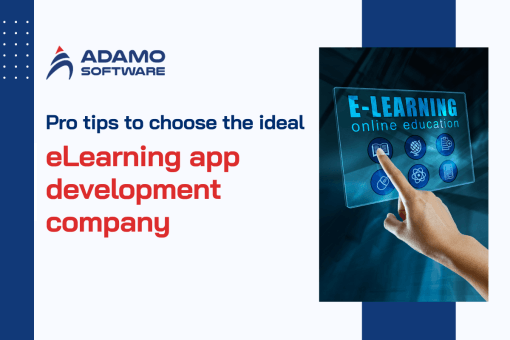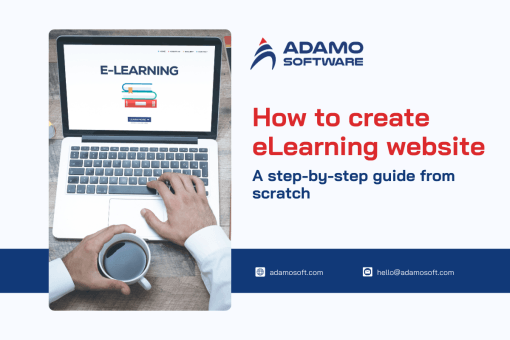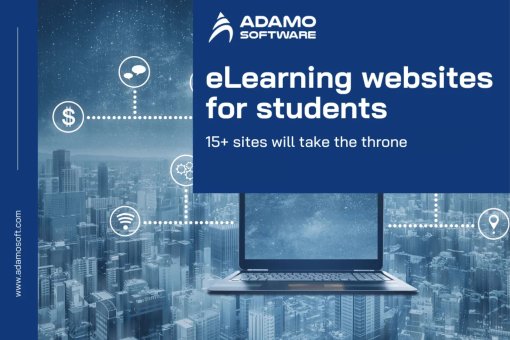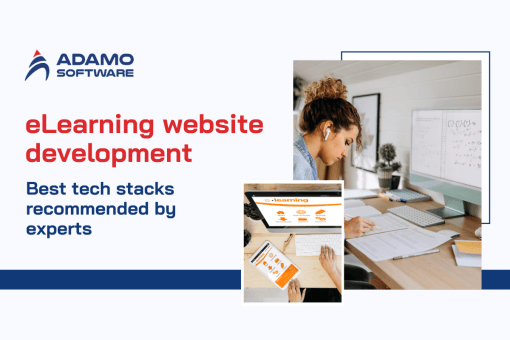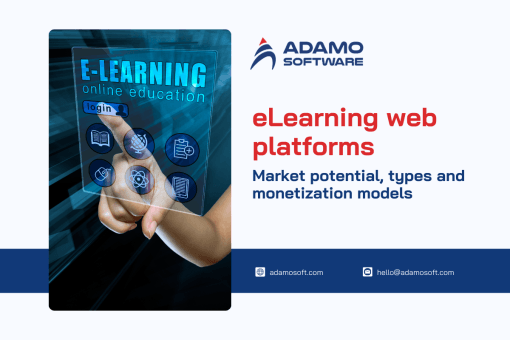Online learning platform development: Key features and cost for a successful platform

The rise of online learning platforms has fundamentally changed how we teach and acquire knowledge by providing people worldwide with a flexible and accessible learning environment. In addition, online learning platforms also offer many opportunities for self-managed learning. These include interactive lessons and customized educational experiences.
This article will dive into online learning platform development and explore their must-have features. Furthermore, we will introduce popular technology stacks for this task and our experience with this type of software. If you want to develop an online learning platform, Adamo will share our experience and knowledge from many online learning platform projects we have helped our clients with.
I. Factors that determine the success of online learning platform development
Based on our extensive experience in developing e-learning websites, we have identified a series of factors that can help you build an online learning platform’s success.

1. Responsive Mobile Design
Since mobile learning will be the preferred hyper-convenient learning method by 2025, the platform’s functionality must be accessible from any device without limitations.
2. Rich communication features
Online learning platforms must provide interactive and communication features to promote social and collaborative learning.
3. Advanced AI capabilities
Provide customized learning experiences that match the learner’s interests, knowledge, skills, and progress.
Also read: Online learning platform definition: How to distinguish it with e-learning
II. 15 crucial features when developing online learning platform development
Here are 15 essential features every online learning platform development should have.
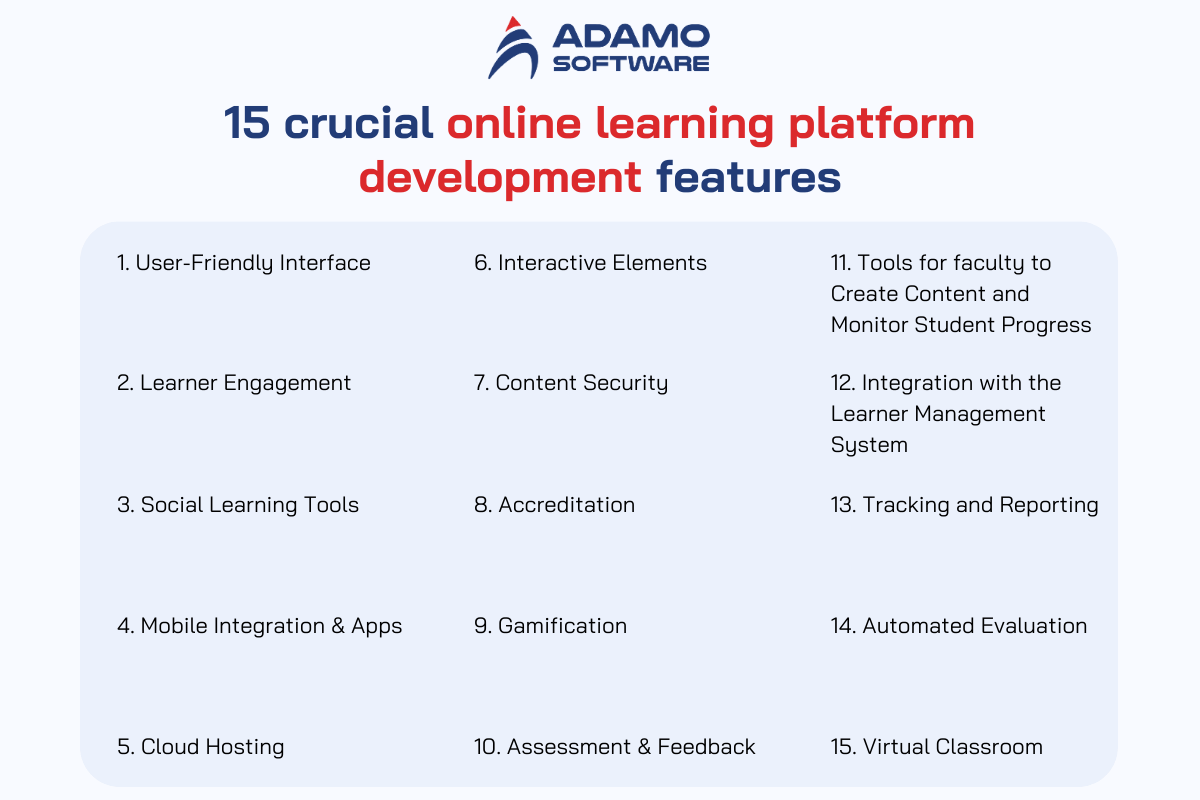
1. User-Friendly Interface
The online learning platform development should be user-friendly and easy to use. Every feature should flow smoothly to enhance the experience of both the instructor and the learner. Learners should be able to log in quickly in just one step. They should be able to navigate the site easily and access relevant learning resources with just a few clicks. This interaction should be maintained throughout the process.
Remember, if your online learning platform development is challenging, your users won’t use it. No matter what the platform offers, it’s a waste of time if your learners can’t access relevant online courses and content easily. The entire user experience should be fluid, simple, and personalized.
2. Learner Engagement
An online learning platform development that only provides access to one or two types of online training and learning resources will reduce learner engagement. It can take you back to the days of clunky and inefficient learning management systems.
At a minimum, your online learning platform development can allow users to upload and view documents, PDFs, images, audio, video, online courses, and live courses. Also, people learn differently, so you need to consider the learner’s preferences.
3. Social Learning Tools
In addition to mandatory learning programs, many companies are now recognizing the value of employee-led collaborative and social learning. Therefore, you can develop a social learning feature for your online learning platform development.
A social learning program supports sharing best practices and debates among students through materials that learners create and participate in. Access to various tools, such as videos, group discussions, forums, and personal blogs, will help learners interact and absorb more knowledge. Furthermore, students can quickly get their classmate’s or teacher’s support to resolve their questions.
Your online learning platform development should be compatible and work across multiple devices and operating systems. It must allow users to create forums and groups for online discussions if you want your online learning platform development website to be successful. It should also allow messaging, video chat, social sharing, and inviting others to join discussions and learning opportunities.
4. Mobile Integration and Apps
The online learning platform development should be compatible and work across multiple devices and operating systems. This eliminates the need for students and parents to purchase new devices compatible with the online learning platform.
In addition, your online learning platform should include mobile-friendly features such as:
- Compatibility with multiple operating systems
- Mobile-friendly design
- Elements should be touch-screen compatible (drag and drop, pinch to zoom, double tap, etc.)
5. Cloud Hosting
It is essential to ensure that there is a cloud platform. In other words, all data, such as emails, application storage, and web-based phone systems, are stored in the cloud. Users can rest assured that their content is always accessible from anywhere and anytime using a cloud solution. Furthermore, the content can be updated continuously, with changes reflected in all e-books.
Hosting content in the cloud should be in a collaborative framework that ensures that the material is always up-to-date and accessible to students without interrupting the teaching cycle. It also allows teachers to create and update content quickly and conveniently. Furthermore, the cloud can support multi-device access anytime, anywhere, and eliminates the need for installation. Teachers and students can access the course via PC, mobile, or tablet through any web browser.
6. Interactive Elements
An online learning platform development should have interactive features like tests, audio files, movies, simulations, and video games. It helps to engage learners and motivate them. Interactive features allow students to take notes and share them with classmates or teachers, bookmark pages, search for information, highlight text, etc. This feature makes learners more engaged in the courseware.
7. Content Security
Having complete control over your online learning platform development’s content is essential. The browser must check every item that the HTML of the website requires, including content security. The browser will not download an image if security does not allow its origin. You can specify a set of rules; anything that does not meet those criteria will be filtered out before it reaches the user’s computer.
This security feature is an effective deterrent to malicious attacks on your website. Users will not be bothered by pop-ups or have their login information revealed to an attacker.
8. Accreditation
Accreditation is essential to verify the professionalism and credibility of the platform’s courses, materials, and teachers. Many websites and platforms have an automated accreditation process. If the platform does not have this process, experts must present their qualifications to the platform management, such as degrees, certificates, and other reputable documents.
This process is considered a standard to ensure that only high-quality content is provided to students after careful review. Moreover, it is a measure to protect the interests of children and parents from fraudulent organizations that want to make a quick buck at the expense of students without caring about the long-term consequences.
9. Gamification
Gamification enhances the learning experience by motivating students throughout the course. It often includes rewarded achievements and integrates features such as badges or points to recognize student effort. Additionally, gamification incorporates leaderboards, allowing students to track their progress and compare themselves to their classmates. It promotes a sense of healthy competition and encourages personal growth.
Benefits of gamification in the learning journey include increased engagement, providing challenges, providing a sense of achievement, and tracking progress:
A more enjoyable learning experience: When students find the learning process fun, they are more likely to continue engaging, leading to improved retention of information.
Immediate Response: Providing users with immediate feedback helps them identify what they have learned and, more importantly, what they still need to grasp. This feedback promotes engagement and aids retention and recall.
A more favorable learning environment: Gamification creates a comfortable atmosphere where students can safely practice real-life situations, enhancing the quality of learning experiences and improving knowledge retention.
Adaptability to various learning needs: For guiding, supporting learners, developing soft skills, or raising awareness, gamification can be adapted to meet multiple learning needs.
Behavioral modification: Besides points, badges, and leaderboards, gamification can promote behavioral changes by encouraging learners to engage more in different learning experiences.
10. Assessment and Feedback
These features motivate learners to develop their abilities as they learn well and point out areas of learning where they need to improve.
Therefore, any online learning platform development must be able to track student progress and evaluate their performance. It must also provide real-time feedback based on their activities and performance. It includes test scores, grades, leaderboards, and course progress tracking feedback. There are multiple grading methods, assessment types, multiple test types, custom test options, testing tools, simulations, and branching scenarios.
11. Tools for faculty to Create Content and Monitor Student Progress
Instructors and students are both influential users of any e-Learning website. Professional teacher management solutions become important when multiple teachers or instructors use your website. An excellent online learning platform development should allow instructors to manage their work. For example, an online learning platform design should be able to add multiple instructors, manage their payments, manage their roles, assign them to other people’s courses, etc. Providing a positive experience for professors and instructors with these essential elements would be easier.
12. Integration with the Learner Management System
This feature is essential to ensure the efficient and timely completion of many activities related to managing an online learning program. Without proper learner management tools, instructors may spend much time on other things besides teaching.
Therefore, some essential features that support easier learner management include the ability to enroll learners in bulk, filter learners based on performance, organize learners into groups, attendance functionality, and allow others to manage learners. These features are a must-have in the development of any online learning platform.
13. Tracking and Reporting
During the learning process, tracking, analyzing, and monitoring student progress is essential to address any learning gaps promptly. Therefore, online learning platforms must have comprehensive data collection and accessible reporting features, which help teachers save time on manual data processing.
14. Automated Evaluation
Automated assessment is an essential feature in the online learning space. It serves two primary purposes: automating the grading process and recording data. Automated grading allows for real-time assessment of tests, providing immediate results to teachers and students. Furthermore, it helps highlight correct and incorrect responses, allowing students to identify and learn from their mistakes. Additionally, the platform can help teachers record students’ daily performance and calculate their GPA and final grade.
15. Virtual Classroom
Flexibility is a significant advantage of online learning and is valued highly by students. Virtual classrooms save costs and use interactive and multimedia materials, enhancing the learning experience.
For example, platforms like CAE integrate with Zoom, MS Teams, and Google Meet, making communication between teachers and students more seamless and enabling remote learning. In addition, they promote active student engagement through live interactions, chat comments, and file sharing. They also track student performance and teacher assessments for reporting and statistics.
III. Recommended tech stacks to build online course website
Choosing a technology stack always depends on the functionality of the platform or application you want to use. It would help to consider different approaches to starting an online learning platform. You cannot define a complete list of all the technologies and tools your development team will use. However, today, you can consider widely used technologies to get the most basic understanding of what you will deal with at the development stage.

– Frontend tech-stack: HTML, ReactJS, JavaScript, CSS3.
– Backend tech-stack: Node.js, PHP, Python.
– Database: MySQL, MongoDB.
– Mobile technology is suitable for operating systems:
Swift and Objective-C (iOS apps)
Java and Kotlin (Android apps)
Flutter and React Native (cross-platform development)
– Video streaming: WebRTC, RTMP.
– Tech-stack for payment gateways: Stripe, Paypal, Google Pay, Apple Pay.
– Cloud Platform: AWS, Google Cloud, Microsoft Azure.
– Push Notifications: Onesignal, Firebase.
– Messaging: Twilio.
IV. Who can be your partner of online learning platform development?
If you are not a developer, this is not a barrier that can stop you from launching an online course marketplace or any other educational platform. So, which vendor can you trust when you want to build a software solution? There are many options available today for your online learning platform development.
1. An in-house team
This option can be a good choice if you feel that you will have many software projects in the future that will require constant support and updates from developers. But don’t forget that even if your in-house developers have little or no work, you still need to pay them. Moreover, don’t forget about insurance and other costs related to hiring and training.
2. Freelancers
When working with freelancers, you can save a lot of costs and time required for administrative procedures. Moreover, if you find freelancers who do not charge high fees, you can save another amount of money. But remember that on freelance platforms, you may encounter unscrupulous professionals who will provide shoddy work, fail to meet deadlines, or complete any tasks even if their services are paid in advance. However, we do not want to scare you. There are many responsible freelancers. However, the problem is that you only know who you will work with after seeing the first results. And you will not be able to control the freelance developers.
3. A dedicated outsourcing team
This business model has been trendy and is gaining popularity thanks to its benefits. As mentioned earlier, this model combines all the most important benefits of both models. You do not have to worry about recruitment procedures. You have significant flexibility in reconfiguring the team if needed. But at the same time, this team will be entirely focused on your project, and you will be able to manage the entire development process.
V. Cost breakdown for building an online learning platform
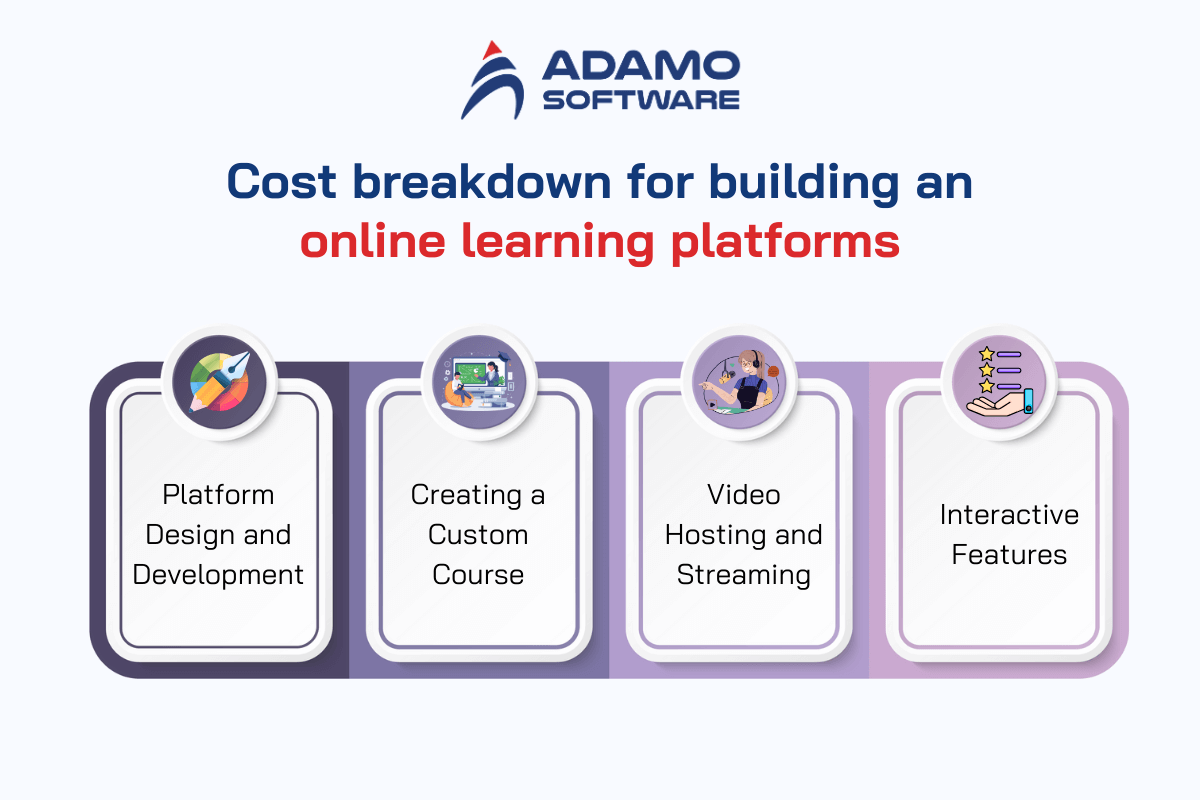
1. Platform Design and Development
Online learning platform development with an interface that users find intuitive and engaging can cost anywhere from $10,000 to $50,000 to design. Depending on the comprehensiveness of the wireframe, prototype, and other final assets. A primary online learning platform should have both backend and frontend development. The estimated range is $30,000 to $150,000, including coding essential features and custom functionalities.
2. Creating a Custom Course
One of the most critical expenses is creating high-quality and engaging content. Building course materials, designing interactive elements, and developing assessments are all part of the process. Each course can range from $5,000 to $50,000, depending on their complexity and length.
Hiring an instructional designer to create practical courses can add to your budget. Depending on the complexity of the course and the designer’s experience, you can expect to spend around $2,000 to $10,000 per course.
3. Video Hosting and Streaming
A professionally produced video can cost anywhere from $2,000 to $20,000 an hour, depending on several factors, including studio rental, camera equipment, and editing. However, prices vary based on the quality of production. Users can only stream video with a good hosting service that ensures the video is secure.
In addition, video hosting can cost anywhere from $500 to around $5,000 a month, depending on storage and bandwidth requirements. For example, while some services are charged by the hour, others charge a flat rate.
4. Interactive Features
Interactive features such as games, quizzes, assignments, and tests can be expensive to integrate into a platform. Integrating these interactive features will cost between $5,000 and $15,000. It will involve developing question banks, automated grading systems, and feedback functionality.
Additionally, if your online learning platform development has live sessions, you will need live-streaming and interactive tools. These can cost up to $2,000 – $10,000, depending on the technology used and the complexity of the integration process.
VI. Adamo Software – Reliable destination for education software development
At Adamo Software, we bring you leading educational software solutions tailored to your unique requirements. Our focus is on creating platforms that are not only functional but also user-friendly and visually appealing.

Our holistic approach ensures that your vision becomes a reality, whether you are building an online learning platform development from scratch or enhancing an existing system. We are dedicated to providing software that makes learning more educational and fun. Adamo is the go-to destination for e-learning platform development.






